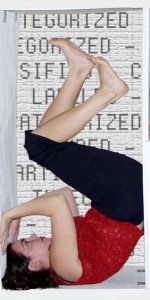by Janet Neidhardt
As a dance educator I am constantly working to find new ways of engaging my students to learn about dance and making dances. Video dance has become more popular with the growth of YouTube and the ever present flash mobs popping up all around the world. It seems everyone has the ability to capture a video on some device and even the technology to edit it has become more mainstream. I have recently heard choreographers say they might start making video dances simply because they think they will get more exposure on YouTube than they will with a performance on a stage.
Last school year I decided to try and teach my high school students how to make a video dance. Together we researched many video dances on YouTube and discussed the site specific use of the environment and the various camera positions and types of framing. With this simple basic information I sent my students off to create their video dances and when they came back I was very impressed with the clear form their videos had taken. I could see how their skills in choreography from class had transferred into the video camera choreography. Their choreographic eye used in the studio was transferred to the camera lens. I was amazed that with such little instruction my students created great works and thought if I was really able to teach them more solid video dance content how much better their projects could be.
I still felt that I needed to learn more about this growing art form of mediated dance in order to better educate my students in the future. As luck would have it I was able to attend the Bates Dance Festival in July 2012, and there I took Media and Performance with Rachel Boggia, Shawn Hove, and Peter Richards. I gained practical experience in making my own video dance as well as a wealth of knowledge from these educators on how to teach students about making compelling video dances.
This Fall I returned to school with a new group of students and assigned a more specific video dance project. I created a clear worksheet with specific “Framing”, “Camera Positions”, and “Camera Movements” vocabulary which we discussed a length while watching and critiquing various video dances online. Through discussion and analyzing the students were able to identify their aesthetic for video dance choreography with the camera lens. I then asked them to pick a location and create movement based on their location for their film shoot. I told them that the environment is another dancer in the work, movement must be in response to the space the dancing is in, use the space like a prop, go over, under, through, around, and above it. I also asked them to shoot for “continuity”, something I learned from the Bates Festival teachers. Shooting for continuity means that a movement is continued from shot to shot. It is important to shoot the same movement sequence several times from several angles to have a variety of choices. Students were more prepared this time around before they went out the film their dances. Because of this preparedness they went out to shoot their dances with more precision and ideas than the group from last year. They added music and edited their footage on their own then presented well thought out, impressive, video dance studies. They all had a clear beginning, middle, and end, and clear motifs.
Since then I have noticed that these students create more successful choreographic works in the studio. They have a sharper eye for details within movement they are performing and movement they are watching. I think that their experience with viewing movement through the camera lens changed how they see movement in a stage space. I plan to keep evolving this video dance project each year.
Some video dances we looked at in class are listed below-
Aroma 2006 by Doug Rosenberg:
Drive 2008 by Jane Osborne:
Horse:

Contributor Janet Neidhardt has been a dance educator for 10 years. She has taught modern, ballet, and jazz at various studios and schools on Chicago’s North Shore. She received her MA in Dance with an emphasis in Choreography from the University of North Carolina-Greensboro and her BA in Communications with a Dance Minor from the University of Wisconsin-Madison. Throughout her time in graduate school, Janet performed with Sidelong Dance Company based in Winston-Salem, NC.
Currently, Janet teaches dance at Loyola Academy High School in Wilmette, IL. She is the Director of Loyola Academy Dance Company B and the Brother Small Arts Guild, and choreographs for the Spring Dance Concert and school musical each year. Janet is very active within the Loyola Academy community leading student retreats and summer service trips. She regularly seeks out professional development opportunities to continue her own artistic growth. Recently, Janet performed with Keigwin and Company in the Chicago Dancing Festival 2012 and attended the Bates Dance Festival.
When she isn’t dancing, Janet enjoys teaching Pilates, practicing yoga, and running races around the city of Chicago




